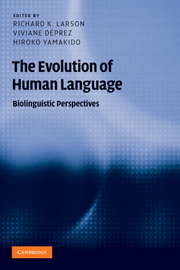Book contents
- Frontmatter
- Contents
- Figures
- Contributors
- Acknowledgments
- Introduction
- 1 The faculty of language: what is it, who has it, and how did it evolve?
- Part I Language architecture
- Part II Language and interface systems
- 6 Prospection as a cognitive precursor to symbolic communication
- 7 Did language evolve before speech?
- 8 A pragmatic perspective on the evolution of language
- Part III Biological and neurological foundations
- Part IV Anthropological context
- Notes
- References
- Index
7 - Did language evolve before speech?
Published online by Cambridge University Press: 05 June 2012
- Frontmatter
- Contents
- Figures
- Contributors
- Acknowledgments
- Introduction
- 1 The faculty of language: what is it, who has it, and how did it evolve?
- Part I Language architecture
- Part II Language and interface systems
- 6 Prospection as a cognitive precursor to symbolic communication
- 7 Did language evolve before speech?
- 8 A pragmatic perspective on the evolution of language
- Part III Biological and neurological foundations
- Part IV Anthropological context
- Notes
- References
- Index
Summary
It is generally agreed that language is uniquely human, at least in the narrow sense of a recursive, generative structure that can convey an unlimited variety of different meanings (e.g., Hauser, Chomsky, and Fitch 2002; Jackendoff 2002; Pinker 1994). This implies that language must have evolved at some time since the hominid lineage split from that leading to modern chimpanzees. There is conflicting evidence as to the precise date of this occurrence, with a recent suggestion that there was an initial split some 7 million years ago, followed by a period of hybridization, then a second split some time after 6.3 million years ago (Patterson et al. 2006). The distinguishing characteristic of the hominids was bipedalism.
Nevertheless it was not until the emergence of the genus Homo, from around 2 million years ago, that there is evidence of a shift from ape-like mentality toward more human-like cognition. Stone tool industries have been dated from about 2.5 million years ago in Ethiopia (Semaw et al. 1997), and tentatively identified with Homo rudolfensis. However these tools, which belong to the Oldowan industry, are primitive, and some have suggested that H. rudolfensis and H. habilis, the hominid traditionally associated with the Oldowan, should really be considered australopithecines (e.g., Wood 2002). The true climb to humanity probably began with the emergence of the larger-brained Homo erectus around 1.8 million years ago, and the somewhat more sophisticated Acheulian tool industry dates from around 1.5 million years ago (Ambrose 2001).
- Type
- Chapter
- Information
- The Evolution of Human LanguageBiolinguistic Perspectives, pp. 115 - 123Publisher: Cambridge University PressPrint publication year: 2010
- 5
- Cited by



